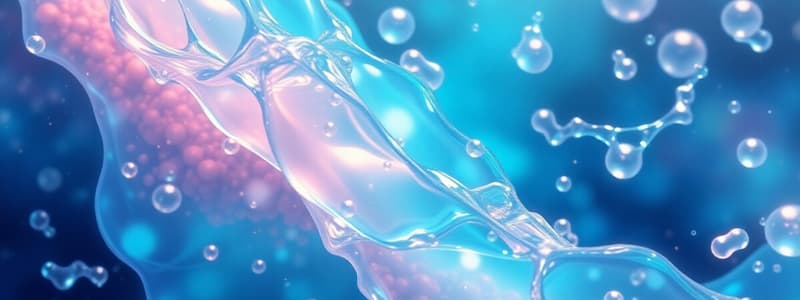Podcast
Questions and Answers
What effect does the presence of Chlorella have on the swelling ratio of hydrogels at lower temperatures?
What effect does the presence of Chlorella have on the swelling ratio of hydrogels at lower temperatures?
- It has no effect on water uptake.
- It decreases water uptake at equilibrium. (correct)
- It only affects the ionic strength of hydrogels.
- It increases water uptake at equilibrium.
Which of the following ions shows the strongest ability to retain water in hydrogel matrices, according to the content?
Which of the following ions shows the strongest ability to retain water in hydrogel matrices, according to the content?
- K+
- Na+
- Ca2+
- Al3+ (correct)
How does the temperature influence the bioactivity of Chlorella in hydrogels?
How does the temperature influence the bioactivity of Chlorella in hydrogels?
- Bioactivity fluctuates but averages out over time.
- Bioactivity increases at higher temperatures.
- Bioactivity decreases at higher temperatures. (correct)
- Bioactivity remains constant regardless of temperature.
In terms of osmotic pressure, what occurs with water molecules in hydrogels?
In terms of osmotic pressure, what occurs with water molecules in hydrogels?
Which ion sequence reflects the order of strength in interacting with hydrogels from high to low?
Which ion sequence reflects the order of strength in interacting with hydrogels from high to low?
How does the swelling degree of chitosan–chlorella hydrogel beads respond to increasing concentrations of salt solutions?
How does the swelling degree of chitosan–chlorella hydrogel beads respond to increasing concentrations of salt solutions?
What is the primary mechanism attributed to the decrease in swelling degree of hydrogel beads with higher salt concentrations?
What is the primary mechanism attributed to the decrease in swelling degree of hydrogel beads with higher salt concentrations?
What effect does temperature have on the swelling of chitosan–chlorella hydrogel beads?
What effect does temperature have on the swelling of chitosan–chlorella hydrogel beads?
In a controlled release system utilizing chitosan–chlorella hydrogels, what would be a major concern with using saline solutions?
In a controlled release system utilizing chitosan–chlorella hydrogels, what would be a major concern with using saline solutions?
Which of the following best describes the behavior of water retention within chitosan–chlorella hydrogels in relation to osmotic pressure?
Which of the following best describes the behavior of water retention within chitosan–chlorella hydrogels in relation to osmotic pressure?
What primarily influences the swelling degree of chitosan–chlorella hydrogel beads?
What primarily influences the swelling degree of chitosan–chlorella hydrogel beads?
What happens to the chitosan–chlorella hydrogel beads when immersed in a buffer solution with a pH of 6?
What happens to the chitosan–chlorella hydrogel beads when immersed in a buffer solution with a pH of 6?
Why do chitosan–chlorella hydrogel beads shrink at a pH of 10?
Why do chitosan–chlorella hydrogel beads shrink at a pH of 10?
Which of the following describes the mechanism responsible for the swelling of the hydrogel beads?
Which of the following describes the mechanism responsible for the swelling of the hydrogel beads?
What is the characteristic of the swelling behavior of these hydrogels based on the application of different saline solutions?
What is the characteristic of the swelling behavior of these hydrogels based on the application of different saline solutions?
How does osmotic pressure relate to the swelling of chitosan–chlorella hydrogel beads?
How does osmotic pressure relate to the swelling of chitosan–chlorella hydrogel beads?
Which effect contributes to the swelling of hydrogel beads in ionic solutions?
Which effect contributes to the swelling of hydrogel beads in ionic solutions?
Which factor primarily determines the reversibility of swelling in chitosan–chlorella hydrogels?
Which factor primarily determines the reversibility of swelling in chitosan–chlorella hydrogels?
Flashcards are hidden until you start studying
Study Notes
Chitosan-Chlorella Hydrogel Beads Swelling
- The swelling of chitosan-chlorella hydrogel beads is influenced by various factors, including the presence of salts, pH, and temperature.
- The water absorption of the beads is stronger in salt solutions with higher Chlorella content.
- The swelling ratio of hydrogel beads decreases with increasing concentration of salt solutions.
- The order of ionic strength of the salt solutions is Al3+ > Ca2+ > Na+
- The beads exhibit pH-dependent swelling reversibility.
- The swelling of the beads is significantly lower in salt solutions compared to distilled water.
- The swelling of the beads occurs due to electrostatic repulsion caused by protonation at pH 6 and shrinks due to deprotonation at pH 10.
- The swelling ratio of the beads decreases with increasing temperature.
- This temperature dependency is attributed to the loss of bioactivity of Chlorella at higher temperatures.
Studying That Suits You
Use AI to generate personalized quizzes and flashcards to suit your learning preferences.




